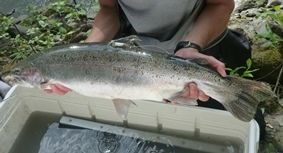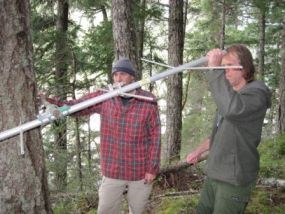|
For over a century, salmon migrations into Olympic National Park have been blocked on the Elwha River by two large hydroelectric dams.Removal of the Elwha and Glines Canyons dams between 2011 and 2014 freed the Elwha River and restored access to over 70 miles of mainstem and tributary habitat for Pacific salmonids. In April 2014, biologists from Olympic National Park, Lower Elwha Klallam Tribe, and U.S. Fish and Wildlife Service began the Adopt-A-Fish radio-tracking project to track the movements of anadromous fish in the Elwha watershed and help illuminate how far, how fast, and where the first salmon recolonizers go after dam removal. Adopt-A-Fish introduces the public and students to radio telemetry techniques, scientific process, methods of tracking, and fish migrations in the nation's largest dam removal project. Regular updates about the project are posted on the Elwha River Restoration Blog. This project is possible through partnerships with the Lower Elwha Klallam Tribe and U.S. Fish and Wildlife Service, and funding generously provided by Washington's National Park Fund.

Tagging and Tracking Pacific Salmon Through the use of radio telemetry, managers will be able to assess fish passage at former dam sites and in the remote upper canyons of the Elwha River. This information is vital to successfully evaluate and understand salmonid restoration in this historic project.Fish are caught in the lower river by fisheries biologists. The fish are then placed in live cages in the river prior to being fitted with individually coded radio tags. Captured fish are anesthetized, radio tagged, and then released near their point of capture in the river. Two types of tagging methods will be used. External tags, attached along the dorsal fin will be used for fish large and fit enough to carry the tag. Smaller fish will have radio tags implanted into their lower abdomen during a fast efficient surgery. All fish captured will be measured, photographed, and fin clips and scale samples will be taken for genetic identification and to determine the age of the fish.


. |
Last updated: May 6, 2025
